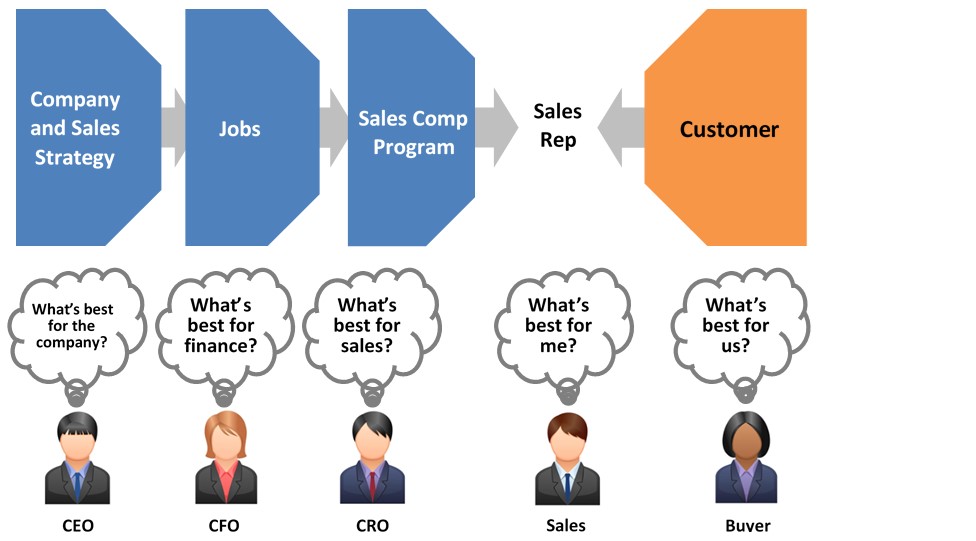Is Your Sales Compensation Plan Working?
Is your sales compensation plan working? How can you tell? Now is the time of year many companies must begin considering changes to the sales compensation program to prepare for the new calendar and fiscal year. The sales compensation program frequently becomes out of date due to market dynamics and changes in company business and/or sales strategy. Over 90 percent of companies make some changes to their sales compensation program every year. Is your company experiencing any of the common signs warranting changes to the sales compensation program?
Signs of Failure
Do you see any of these signs within your company?
- “King pin” sales representatives. Some sales people are absolutely crushing their number. Finance is growing concerned.
- Starving sales representatives. Too many are well behind achieving quota. Some are becoming disenfranchised, “checking out,” or even leaving.
- Comfortable sales representatives. The current plans don’t seem to motivate high performance. The company may be suffering from a “nice place to work” syndrome.
- Inquisitive sales representatives. They are spending too much time doing “shadow accounting” to ensure proper credit on sales.
- Confused sales representatives. They can’t understand the plans or the calculations. Many simply give up trying, trusting their manager will take care of them as they “do the right thing” (which may or may not be the desired behavior).
- Complaining sales representatives. Handling the complaints and exceptions is causing sales ops/finance to work overtime.
- Happy and quiet sales representatives. Actually this is problematic as well. Sales compensation programs by nature are “noisy.” If all is quiet, there is likely something wrong.
If your company is experiencing one or more of the above scenarios, it may be time to evaluate and update your sales compensation program.
Signs of Change
There are also several company and market dynamics that signal the need for plan evaluation and redesign, including:
- Mergers or acquisitions. Sales compensation programs must align across merged sales forces.
- New products. Launching new products often calls for special sales incentive attention.
- New markets or customer segments. Expansion in to new markets or customer segments often warrants plan updates.
- Route to market changes. Shifts in coverage from field to inside, direct to channel, or visa-versa calls for sales compensation redesign.
- New jobs. Deploying new roles involves ensuring the right sales plans for each job.
- Changing jobs. Changes to the focus or objectives of one or more jobs in the sales force is one of the most common reasons for plan design change.
- Revenue model changes. For example, when a software company changes from perpetual license deals to subscription deals, or from fixed contracts to usage-/consumption-based pricing, they will need to update the sales compensation plans.
- Changes in competition. Competitor advances and moves may warrant sales compensation adjustments.
- New executive leadership. This may trigger a shift in pay philosophy, warranting plan updates.
- Location change. This could trigger the need to adjust pay mix and pay levels.
What Makes Plans Work?
The key is alignment. It starts with the company strategy and sales strategy. Strategy drives job design. Sales compensation plans follow jobs. There are many variables at play and many voices in the mix. Good sales compensation plans help motivate the sellers to perform in a way that achieves success for the customer, the company and their pocketbook. When sales incentives tilt too heavily in any one direction, problems arise. Tilt them in favor of the company, and sellers may not earn enough. Tilt them in favor of sales representatives, and customers and sales costs increase while margins decrease. Tilt them too heavily to both the company and sales people, and customers can get burned. Consider, for example, the recent situation at Wells Fargo where a poorly designed and managed sales incentive program led to overly aggressive bundling and cross-selling.
The first step involves assessing the current sales compensation program. Gather internal data on company objectives, pay philosophy, pay and performance analysis, sales budget, and sales representative and management perspectives. Next gather market data on pay practices for your industry. Finally evaluate your plan designs against best practice. Invest the time to conduct a thorough assessment. Doing so provides leadership with needed perspective, so they can determine the design objectives and direction for the new year.
View the recording or download the eBook of Alexander Group’s recent webinar, Does Your Sales Compensation Program Work?
Learn more about conducting a thorough assessment of your sales compensation program.
Speak with an Alexander Group consultant about your sales compensation program.
Original author: Paul Vinogradov
